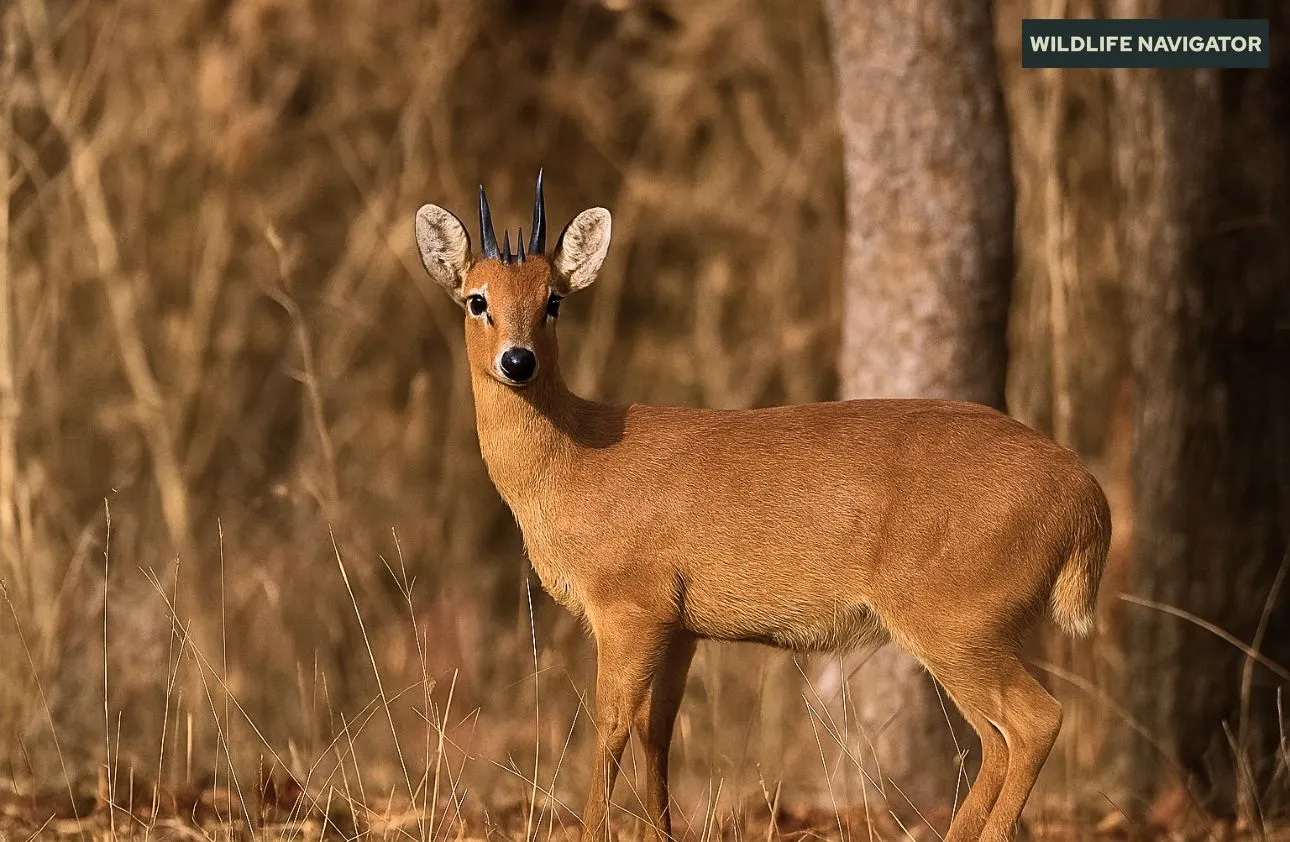Four-Horned Antelope | Chousingha: India’s Rare Four-Horned Wonder

The Four-horned Antelope, scientifically known as Tetracerus quadricornis and locally called Chousingha, is one of India’s most unique and fascinating wildlife species. Unlike most antelopes, which have only two horns, the male Four-horned Antelope sports four distinctive horns, making it a true rarity in the animal kingdom.
These antelopes are small, shy, and often elusive, preferring to stay hidden in dense scrub forests and hilly terrains. Despite their modest size, they play an important role in India’s ecosystem as herbivores, helping maintain the balance of forest vegetation.
Currently classified as Vulnerable on the IUCN Red List, Four-horned Antelopes face threats from habitat loss and poaching. However, India’s network of national parks, wildlife sanctuaries, and tiger reserves provides a safe haven for these incredible creatures.
Explore the physical features, habitat, behaviour, conservation, and best places to spot this rare antelope in India.
Physical Characteristics
The Four-horned Antelope is a small and graceful antelope, yet its unique appearance makes it stand out among India’s wildlife. Here’s a closer look at what makes it so special:
Appearance
- The coat is light brown to yellowish, with a slightly darker shade along the back.
- Its underbelly and inner thighs are white, providing natural camouflage in dry forests.
- The face is delicate with large, alert eyes and rounded ears that aid in detecting predators.
Horns
- Only males have four horns, which is extremely rare among antelopes.
- The front pair of horns is smaller, usually 2–4 cm long.
- The rear pair is larger, typically 8–12 cm long.
- Females are usually hornless, making the males’ four-horned appearance even more striking.
- Horns are slightly curved backwards, giving them a distinct profile from other antelope species.
Size and Weight
- Height: Around 60–85 cm at the shoulder.
- Body Length: 85–125 cm from head to tail.
- Weight: Males weigh between 17–22 kg, while females are slightly lighter.
Distinguishing Features
- Unlike similar antelopes such as the Blackbuck or Nilgai, the Four-horned Antelope is smaller, solitary, and more secretive.
- Its four horns and slender build are the easiest ways to identify it in the wild.
This combination of subtle colouring, unique horns, and modest size makes the Four-horned Antelope both elusive and captivating for wildlife enthusiasts and photographers.
Habitat and Distribution
The Four-horned Antelope (Tetracerus quadricornis) is a rare and shy species, native mainly to the Indian subcontinent. Its distribution is limited compared to other antelopes, making sightings a special experience for wildlife enthusiasts.
Natural Habitat
- Dry deciduous forests, scrublands, and rocky hilly areas.
- Prefers dense undergrowth or rocky terrain for shelter.
- Avoids open grasslands due to predator vulnerability.
Global Distribution
- India: The primary stronghold for the species.
- Nepal: Scattered populations in the lowland forests and Churia Hills.
Key Locations in India
You can spot Four-horned Antelope in several national parks, tiger reserves, and wildlife sanctuaries:
- Madhya Pradesh:
- Maharashtra:
- Tadoba Andhari Tiger Reserve
- Melghat Tiger Reserve
- Odisha:
- Uttarakhand:
- Karnataka:
- Jharkhand & Chhattisgarh:
Best Conditions for Chousingha Sightings
- Active mostly at dawn and dusk.
- Typically solitary or in pairs, making careful observation and patience essential.
- Rocky patches and scrub forests increase the chances of spotting them.
Four-horned Antelopes are rarely found outside protected areas, which makes wildlife sanctuaries and tiger reserves their safest habitats.
Behaviour and Ecology
The Four-horned Antelope is a small, secretive species that prefers solitude or very small groups. Understanding its behavior helps wildlife enthusiasts and photographers anticipate sightings and respect its natural rhythms.
Diet
- Herbivorous, feeding mainly on:
- Leaves of shrubs and trees
- Fruits and flowers
- Grasses and herbs
- Forages mostly during early morning and late evening, avoiding the heat of the day.
Activity and Social Behavior
- Primarily solitary, though small groups of 2–3 individuals may occur, especially females with calves.
- Shy and alert, they rely heavily on camouflage and quiet movement to avoid predators.
- Typically crepuscular (active at dawn and dusk).
Breeding
- Mating season usually occurs in late summer to early monsoon, varying slightly by region.
- Gestation lasts approximately 180–210 days, resulting in a single calf.
- Calves are well-camouflaged and hidden in dense vegetation for safety.
Predators and Threats
- Natural predators include:
- Tigers
- Leopards
- Wild dogs (dholes)
- Large snakes (occasionally)
- Human-induced threats: habitat loss, poaching, and disturbance from tourism.
Behavioral Adaptations
- Excellent climbing ability in rocky terrain.
- Highly alert with acute hearing and vision, allowing it to detect danger quickly.
- Uses camouflage and quiet movement to remain hidden from predators and humans alike.
Unlike more social antelopes, the Four-horned Antelope’s solitary nature reduces competition for food and makes it more elusive for observers.
Conservation Status
The Four-horned Antelope is classified as Vulnerable on the IUCN Red List, meaning it faces a high risk of endangerment in the wild. While it is legally protected, several factors continue to threaten its survival.
Major Threats
- Habitat Loss: Deforestation, agricultural expansion, and infrastructure development reduce its natural habitats.
- Poaching: Although not a primary target, it is sometimes hunted for its meat or horns.
- Human Disturbance: Increasing tourism, livestock grazing, and forest encroachment disrupt their natural behavior.
Protection Measures
- Included under Schedule I of the Wildlife Protection Act of 1972, granting the species the highest legal protection in India.
- Protected populations exist in:
- National Parks: Jim Corbett, Bandhavgarh, Nagarhole
- Tiger Reserves: Kanha, Tadoba Andhari, Melghat
- Wildlife Sanctuaries: Satkosia, Palamau
- Strict monitoring and anti-poaching patrols help stabilize local populations.
Conservation Success Stories
- Kanha National Park (MP): Steady sightings in the core and buffer zones, showing adaptation to protected areas.
- Tadoba Andhari Tiger Reserve (MH): Reports of increasing numbers due to strict forest protection.
- Nagarhole National Park (KA): Solitary individuals thriving in undisturbed forest patches.
While the Four-horned Antelope remains elusive, its survival depends on protected forests, legal enforcement, and habitat restoration efforts. Conservation programs that reduce human interference have been most successful.
Tips for Wildlife Enthusiasts
Spotting the elusive Four-horned Antelope in its natural habitat requires patience, preparation, and respect for its environment. Here are some practical tips for wildlife lovers and photographers:
Timing
- Most active during early morning (sunrise to 9 AM) and late afternoon (4–6 PM).
- Avoid the midday heat, as they typically hide in dense vegetation.
Observation Tips
- Move quietly and slowly, minimising sudden noises.
- Use binoculars for distant sightings; they are shy and usually stay hidden.
- Look for footprints, droppings, or signs of grazing to locate their presence.
Photography Tips
- Use a telephoto lens (200–400mm) to capture images without disturbing them.
- Camouflage clothing or staying inside a hide/blind increases sighting chances.
- Avoid flash photography, which may startle or stress the animal.
Responsible Wildlife Tourism
- Respect boundaries; do not enter restricted zones.
- Avoid littering or disturbing the habitat.
- Follow park rules and guidance from forest staff.
Pro Tip: Patience is key. Spotting a Four-horned Antelope is a rewarding experience for those who observe silently and respect its natural behavior.
Interesting Facts of Four Horned Antelope
The Four-horned Antelope is not only unique in appearance but also full of intriguing traits that make it a fascinating species for wildlife enthusiasts. Here are some interesting facts:
- Only Antelope with Four Horns
- Among the world’s antelopes, the Four-horned Antelope is one of the very few species to have four horns, all found in males.
- Elusive and Solitary
- Unlike herd-forming antelopes such as Blackbuck or Nilgai, they are mostly solitary, making sightings rare and special.
- Expert Camouflage
- Their light brown coat blends perfectly with dry forests and scrublands, helping them avoid predators.
- Hiding Calves
- Newborns are hidden in dense vegetation for safety, and mothers return periodically to nurse them.
- Shy Climbers
- Four-horned Antelopes are good climbers, often moving across rocky hills and uneven terrain with ease.
- Territorial Behavior
- Males may mark small territories using scent glands, though they are less aggressive compared to larger antelopes.
- Cultural Significance
- Known as Chousingha in local Indian languages, meaning “four horns,” they feature in some tribal folklore and local conservation stories.
Because of their rarity and unique appearance, Four-horned Antelopes are highly prized for wildlife photography and conservation awareness campaigns.
Conclusion
The Four-horned Antelope (Tetracerus quadricornis) is one of India’s most unique and captivating antelopes, easily recognised by the four horns of males and its small, graceful build. Its shy and solitary nature makes it elusive, but protected forests, national parks, and tiger reserves across India provide safe havens where it continues to thrive.
Conservation efforts, strict legal protection, and responsible wildlife tourism are essential to ensure its survival. Observing this remarkable antelope in its natural habitat is not only a treat for wildlife enthusiasts but also a reminder of the importance of preserving India’s rich biodiversity.
By respecting its habitat, following park guidelines, and supporting conservation initiatives, we can help ensure that future generations can enjoy the sight of this rare species.





